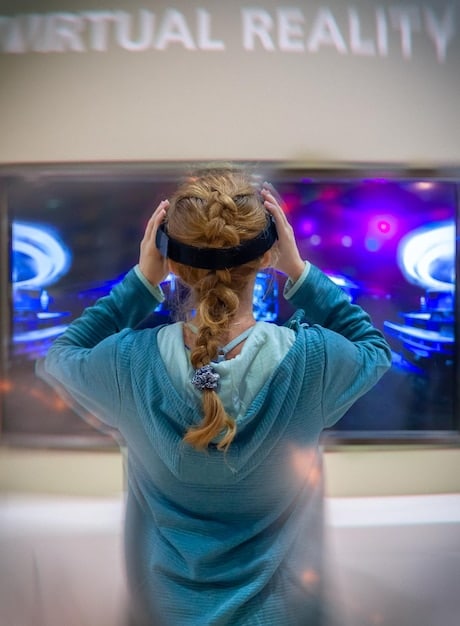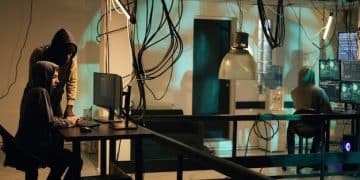The Future of Cinema: Tech’s Impact on Movie Making

The Future of Cinema: How Technology Is Transforming Movie Making involves groundbreaking advancements like virtual production, AI-driven tools revolutionizing workflows, and immersive experiences via VR/AR, significantly altering storytelling and audience engagement in film.
The landscape of cinema is undergoing a dramatic transformation, driven by rapid technological advancements. The future of cinema: how technology is transforming movie making is not just about improved special effects; it’s a fundamental shift in how stories are conceived, produced, and experienced.
The Rise of Virtual Production
Virtual production is revolutionizing how films are made, allowing filmmakers to blend live-action footage with computer-generated imagery (CGI) in real-time. This approach offers unprecedented flexibility and control over the final product.
What is Virtual Production?
Virtual production involves using LED screens and game engine technology to create realistic environments on set. Actors perform in front of these screens, which display real-time CGI backgrounds, eliminating the need for extensive post-production work.
Benefits of Virtual Production
Virtual production offers numerous advantages over traditional filmmaking techniques, including reduced costs, increased creative control, and enhanced collaboration between departments.
- Cost Savings: By reducing the need for physical sets and location shoots, virtual production can significantly cut production costs.
- Creative Control: Filmmakers have greater control over the environment and can make changes on the fly, without waiting for post-production.
- Collaboration: Virtual production fosters collaboration between different departments, as everyone can see the final result in real-time.
Virtual production represents a paradigm shift in filmmaking, offering filmmakers new tools and techniques to bring their visions to life with greater efficiency and creativity. The technology is rapidly evolving, and we can expect to see it become even more prevalent in the years to come.

AI Integration in Filmmaking
Artificial intelligence (AI) is rapidly becoming an integral part of the filmmaking process, impacting everything from scriptwriting and pre-visualization to editing and post-production. AI-driven tools are enhancing efficiency and enabling new creative possibilities.
AI in Scriptwriting and Storyboarding
AI algorithms can analyze vast amounts of data to identify trends and patterns in storytelling, helping writers to craft more compelling and engaging narratives. AI can also assist in creating storyboards and pre-visualizations, allowing filmmakers to visualize their scenes before shooting.
AI in Editing and Post-Production
AI is transforming the editing and post-production workflows, automating tasks such as color correction, visual effects, and sound design. AI-powered software can analyze footage and suggest optimal cuts, saving editors countless hours of work.
- Automated Editing: AI can analyze footage and suggest optimal cuts, streamlining the editing process.
- Visual Effects: AI can assist in creating complex visual effects, such as removing unwanted objects or adding realistic textures.
- Sound Design: AI can generate realistic soundscapes and improve the overall audio quality of the film.
The integration of AI in filmmaking is still in its early stages, but its potential is immense. As AI technology continues to evolve, we can expect to see it play an even greater role in all aspects of the filmmaking process, enabling filmmakers to create more immersive and engaging cinematic experiences.
Immersive Experiences with VR and AR
Virtual Reality (VR) and Augmented Reality (AR) are opening up new possibilities for immersive storytelling and audience engagement. These technologies allow viewers to step inside the world of the film and interact with the characters and environment in a whole new way.
VR Filmmaking Techniques
VR filmmaking requires a different approach to traditional filmmaking, as the viewer has complete control over their perspective. Filmmakers must carefully consider the placement of cameras and the pacing of the story to ensure a comfortable and engaging viewing experience.
AR Integration in Cinema
AR technology can be integrated into cinema experiences to enhance the viewing experience. For example, viewers could use their smartphones to access additional content or interact with virtual objects on the screen.

- Interactive Storytelling: VR and AR allow viewers to become active participants in the story, making choices that affect the outcome.
- Enhanced Engagement: Immersive experiences can create a stronger emotional connection between the viewer and the film.
- New Revenue Streams: VR and AR can create new revenue streams for filmmakers, such as interactive games and virtual tours.
VR and AR are transforming the way we experience cinema, opening up new possibilities for immersive storytelling and audience engagement. As these technologies become more accessible, we can expect to see them play an increasingly important role in the future of cinema.
Challenges and Opportunities
While technology offers tremendous opportunities for filmmakers, it also presents several challenges. Addressing these challenges is essential to ensure that technology enhances, rather than hinders, the art of filmmaking.
Ethical Considerations
The use of AI in filmmaking raises ethical questions about authorship, authenticity, and the potential for bias. It’s crucial to establish guidelines and standards for the ethical use of AI in the industry.
Skills Gap and Training
The rapid pace of technological change requires filmmakers to continuously update their skills and knowledge. Educational institutions and industry organizations must provide training and resources to help filmmakers adapt to new technologies.
The future of cinema hinges on our ability to navigate the challenges and embrace the opportunities presented by technology. By addressing ethical concerns, investing in training, and fostering collaboration, we can ensure that technology enhances, rather than hinders, the art of filmmaking. The ongoing integration promises to revolutionize how stories are told and experienced, opening new vistas of creativity and audience engagement.
The Democratization of Filmmaking
One of the most significant impacts of technology on cinema is the democratization of filmmaking. Affordable cameras, editing software, and distribution platforms have made it easier than ever for independent filmmakers to bring their visions to the world.
Affordable Technology
The cost of filmmaking equipment has plummeted in recent years, making it accessible to a wider range of filmmakers. High-quality cameras, editing software, and sound equipment are now available at a fraction of the cost they were just a few years ago.
Online Distribution Platforms
Online distribution platforms like YouTube, Vimeo, and Amazon Prime Video have made it easier for independent filmmakers to reach a global audience. These platforms offer filmmakers the opportunity to showcase their work and build a following without relying on traditional distribution channels.
- Accessibility: Affordable technology and online distribution platforms have made filmmaking more accessible to a wider range of people.
- Diversity: The democratization of filmmaking has led to a more diverse range of voices and perspectives in cinema.
- Innovation: Independent filmmakers are pushing the boundaries of storytelling and experimentation, leading to new and innovative forms of cinema.
The democratization of filmmaking is empowering independent filmmakers and fostering a more vibrant and diverse cinematic landscape. This trend is likely to continue, as technology becomes even more affordable and accessible, paving the way for a new generation of filmmakers to emerge and share their stories with the world.
The Evolution of the Movie Theater Experience
While technology is transforming filmmaking itself, it’s also revolutionizing the movie theater experience. Enhanced sound systems, immersive visuals, and interactive technologies are creating new and engaging ways for audiences to enjoy films.
IMAX and Dolby Atmos
IMAX and Dolby Atmos are enhancing the cinematic experience with larger screens, brighter images, and more immersive sound systems. These technologies are bringing viewers closer to the action and creating a more visceral and engaging experience.
Interactive Cinema and Gamification
Interactive cinema and gamification are blurring the lines between film and video games, allowing viewers to interact with the story and characters in real-time. These technologies are creating new and exciting ways for audiences to engage with cinema and promises a high impact on the future of cinema: how technology is transforming movie making.
The evolution of the movie theater experience is ensuring that cinema remains a vibrant and engaging form of entertainment. As technology continues to advance, we can expect to see even more innovative and immersive ways for audiences to enjoy films in the years to come. Changes in cinematic tech will likely bring viewers closer than ever before with their favorite films.
| Key Point | Brief Description |
|---|---|
| 🎬 Virtual Production | Real-time CGI environments on set, reducing post-production costs. |
| 🤖 AI Integration | AI assists in scriptwriting, editing, and visual effects. |
| 👓 VR/AR Experiences | Immersive storytelling that allows audience to engage actively. |
| 🌐 Democratization | Accessible tech empowers independent filmmakers globally. |
FAQ
▼
Virtual production allows filmmakers to create realistic CGI environments in real-time, reducing post-production costs and increasing creative control. The blend enhances the storytelling and production process.
▼
AI assists in scriptwriting, editing, and VFX, automating tasks, improving efficiency, and enabling new creative possibilities. Its impact ranges from pre-production to post-production phases effectively.
▼
VR and AR offer immersive storytelling, allowing viewers to interact with the film’s world and characters. This creates deeper emotional connections and transforms passive viewing into active participation.
▼
Ethical concerns include authorship, authenticity, and potential biases in AI algorithms. Establishing guidelines is crucial for the ethical and responsible use of AI within the film industry context.
▼
Affordable cameras, editing software, and online distribution platforms have made filmmaking accessible to diverse creators. They enable them to share their stories globally without relying on traditional studios.
Conclusion
The convergence of technology and cinema is reshaping the landscape of filmmaking, offering unprecedented creative opportunities and transforming audience engagement. From virtual production and AI integration to immersive experiences, the future of cinema promises to be a dynamic and transformative journey, blending artistic vision with technological innovation.





